Triangles:
A triangle is a polygon having three sides. Sum of all the angles of triangle=180°. Types of Triangles: Acute angle triangle : Triangle with all three angle acute (less than 90°). Obtuse angle Triangle : Triangle with one of the angle more than 90°.
Right angle Triangle:
Triangle with one angle equal to 90°. Equilateral Triangle - Triangle with all sides equal. All the angles in such triangles measures 60°. Isosceles Triangle: Triangle with two of its side equal and consequently the angles opposite the equal sides are also equal. Scalene Triangle: Triangle with none of the sides equal to any other side.
General Properties of triangles:
1. Sum of the length of any two sides of a triangle has to be always greater than the third side.
2. Difference between the lengths of any two sides of a triangle has to be always lesser than the third side.
3. Side opposite to the greatest angle will be the greatest and the side opposite to the smallest angle the smallest.
4. The sine rule: a/sin A = b/sin B = c/sin C = 2R. (Where R = cir-cum radius).
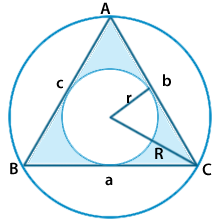
5. The cosine rule: a2 = b2 + c2 - 2bc cos A. This is holds true for all sides and respective angles. In case of right angle, a2 = b2 + c2.
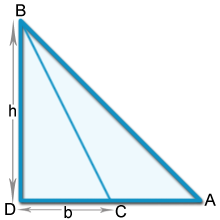
6. The exterior angle is equal to the sum of two interior angles not adjacent to it. In figure below,
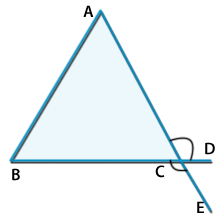
∠ACD + ∠BCE = ∠A + ∠B
Area of Triangles:
1. Area = $$\frac{1}{2}$$ × bas × Height ( Height = Perpendicular distance between base and vertex opposite to it.)
2. Area (Hero's Formula) = [s × (s-a) × (s-b) × (s-c)]
s = semi-perimeter of triangle = $$\frac{{{\text{a}} + {\text{b}} + {\text{c}}}}{2}$$ (a, b and c are being the length of the sides.)
3. Area = r × s (r = in-radius)
4. Area = $$\frac{1}{2}$$ × product of two sides × sine of the included angle
= $$\frac{1}{2}$$ × ac sin B
= $$\frac{1}{2}$$ × ab sin C
= $$\frac{1}{2}$$ × bc sin A
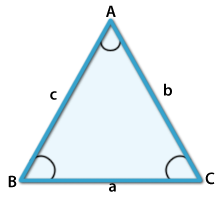
4 Area = $$\frac{{{\text{abc}}}}{{4{\text{R}}}}$$ (R = Circum radius)
Condition For Congruency :
SAS congruency :
AB = PQ
BC = QR
and ∠B = ∠Q
So,∠ABC ∽ ∠PQR
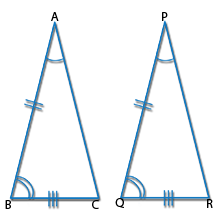
ASA congruency : ∠A = ∠P
∠B = ∠Q
and AB = PQ
So, ∠ABC ∽ ∠PQR
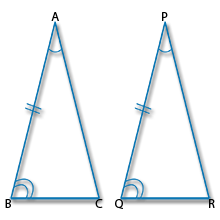
SSS congruency :
AB = PQ
BC = QR
AC = PR, Then,
∠ABC ∽ ∠PQR
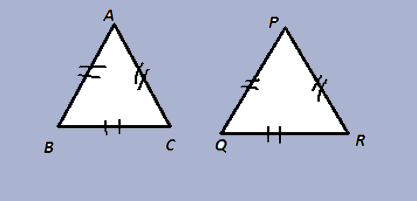
SSA congruency :
AB = PQ
∠B = ∠Q
AC = PR, Then,
∠ABC ∽ ∠PQR

Similarity of Triangles :
Two triangles are said to be similar if the corresponding angles are congruent and their corresponding sides are in proportion. Symbol of similarity is ~
Condition for Similarity:
AA similarity :
If two angle of one triangle are congruent to the corresponding two angles of the other triangle.
∠B = ∠Q
∠C = ∠R
Then, ∠ABC ~ ∠PQR
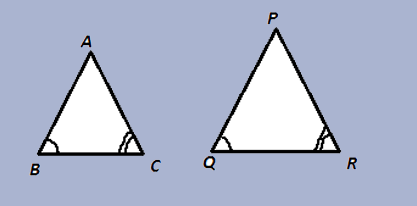
SAS similarity :
If the two sides of one triangle are proportional to the corresponding two sides of the other triangle and the angle included by them are congruent. $$\frac{{{\text{AB}}}}{{{\text{PQ}}}} = \frac{{{\text{BC}}}}{{{\text{QR}}}}$$ and
∠B = ∠Q the,
∠ABC ~ ∠PQR
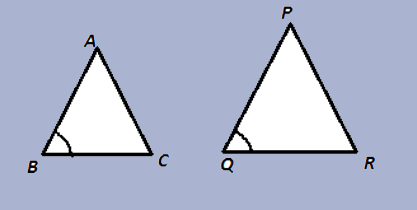
SSS Similarity :
If three sides of one triangle are proportional to the corresponding three sides of the other triangle, then the two triangles are similar.
$$\frac{{{\text{AB}}}}{{{\text{PQ}}}} = \frac{{{\text{BC}}}}{{{\text{QR}}}} = \frac{{{\text{AC}}}}{{{\text{PR}}}}$$ Then,
∠ABC ~ ∠PQR
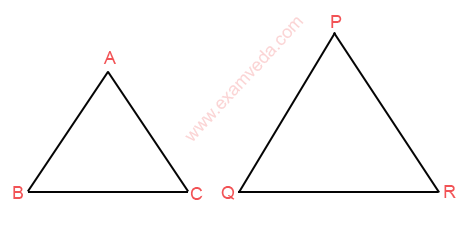
If two triangles are similar, then
1. Ratio of sides = Ratio of height (altitudes)
Ratio of sides = Ratio of medians
Ratio of sides = Ratio of Ratio of angle bisectors
Ratio of sides = Ratio of in-radii
Ratio of sides = Ratio of circum radii
2. Ratio of Areas = Ratio of square of corresponding sides.
Formula on Equilateral Triangles (Side = a)
1. Height = $$\frac{{{\text{a}}\sqrt 3 }}{2}$$
2. Area = $$\frac{1}{2}$$ × base × height = $$\frac{1}{2}$$ × a × $$\frac{{{\text{a}}\sqrt 3 }}{2}$$ = $$\frac{{\sqrt 3 }}{4}$$ × a2
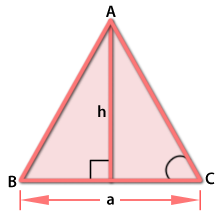
3. R (Circum Radius) = $$\frac{{2{\text{h}}}}{3} = \frac{{\text{a}}}{{\sqrt 3 }}$$
Properties of Equilateral Triangle:
1. The incentre and circumcentre lies at a point that divides height in the ratio 2 : 1.
2. The cir-cum radius is always twice the in radius. (R = 2r)
3. Among all the triangles that can be formed with a given perimeter, the equilateral triangle will have the maximum area.
4. An equilateral triangle in a circle will have the maximum area compared to other triangles inside the same circle.
Isosceles Triangle :
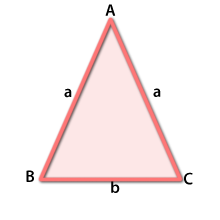
Area = $$\frac{{\text{b}}}{4} \times \sqrt {4{{\text{a}}^2} - {{\text{b}}^2}} $$
In an isosceles triangle, the angle opposite to equal sides are equal.
Right Angle triangle :
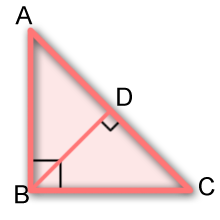
Pythagoras Theorem :
In the case of a right angled triangle, the square of the hypotenuse is equal to the sum of the square of the other two sides. In ∠ABC
1. a2 = b2 + c2
2. Area = $$\frac{1}{2}$$ × (Product of the perpendicular sides) = $$\frac{1}{2}$$ × base × height
3. R (cir-cum radius) = $$\frac{{{\text{hypotenuse}}}}{2}$$
4. Area = rs
(where r = in radius, and s = $$\frac{{{\text{a}} + {\text{b}} + {\text{c}}}}{2}$$ = semi-perimeter)

Join The Discussion